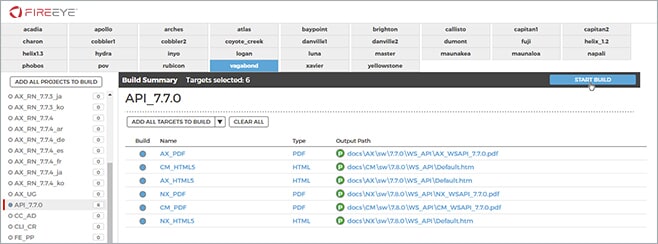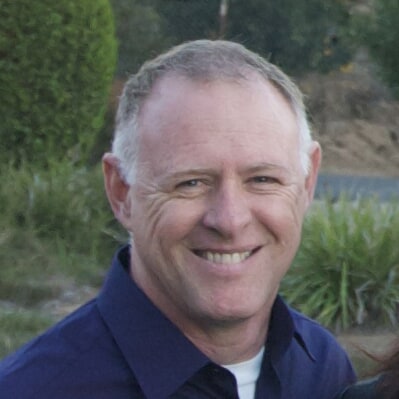Customer Success Story
FireEye Uses MadCap Flare and MadCap Lingo to Publish Print and Responsive Web Content in Multiple Languages for One-Tenth the Cost of Traditional CMS Solutions
Goals
- Streamline the process of creating and delivering XML-based print and web through topic-based authoring and single-source publishing.
- Enhance customers’ experiences by making it easier to navigate the content and locate information.
- Lower the cost and effort associated with translating FireEye’s documentation into six languages.
Benefits
- Efficiency: Flare’s integration with FireEye’s engineering CMS and build tools allows the team to drastically reduce the time writers spend publishing their content.
- Ease-of-Use: HTML5-based responsive design and top navigation give users an intuitive, seamless web experience on their devices of choice.
- Improved Navigation: Flare’s HTML5 frameless output and thumbnail images enable users to easily find and access information.
- Cost-Effective Translation: Integration between MadCap Lingo and Flare eliminates redundancies in translating FireEye’s documentation into six languages, saving time and money.
MadCap Software Solutions and Services:
Every day, FireEye is on the frontlines of cyber attacks and uses its real-time knowledge of the threat landscape as a guide for product innovation. By knowing how adversaries bypass defenses, FireEye is able to build solutions that combat very sophisticated attackers, and a used by frontline experts who then refine the technology in the field to help FireEye provide entities with an incredible line of defense against cyber security threats.
Through this unique innovation cycle, FireEye products and services are designed to meet the challenges of a dynamic threat landscape, creating a cyber defense platform that functions as a seamless, on-demand extension of our customers’ security operations. FireEye is on the frontlines of the cyber war combating the most sophisticated adversaries and defending customers against some of the most complex attacks in the cyber-world.
The FireEye documentation team supports more than 20 products and platforms, and at any one time, this team has more than 100 active documents in work. To ensure that the team can deliver consistent and accurate documentation as both PDFs and responsive HTML5 pages, which automatically optimize the view of content for different screens that can be viewed from any device, the team chose MadCap Flare.
Furthermore, by taking advantage of the single-source, multi-channel publishing capabilities and native XML functionality of MadCap Flare, FireEye has materially reduced the time that writers spend on translation and localization efforts from 20% to about 5% of each writer’s time. Additionally, using MadCap Lingo, FireEye has streamlined its translation and localization efforts while at the same time substantially reducing its costs.

Screenshot of FireEye's HTML5-based Documentation
Seeking an Affordable XML Alternative
Before becoming a publicly traded company five years ago, FireEye used a collaboration platform from another vendor to create and store its product documentation. However, as the company grew, FireEye believed that this particular third-party tool did not offer the flexibility they needed, nor was it robust enough to handle the growth that FireEye was experiencing.
Realizing the need for a more efficient and streamlined approach to writing, sharing, and publishing content, the team decided that the best strategy would be to migrate to an XML tool. At the same time, FireEye did not want to spend the enormous amount of money or resources required to implement a traditional XML system. The search for an alternative, more cost-effective solution led the company to MadCap Flare, since it combined native XML and robust multi-channel publishing functionality with rich features for enhanced usability, including a “what you see is what you get” (WYSIWYG) editor.
“I quickly realized the value of MadCap Flare once I started playing around with the tool. Its native XML functionality not only fit our requirements without having the astronomically high cost of a full-blown XML system; it was also by far the best writing tool to use from a usability standpoint,” recalled Michael Scruggs, senior director of information experience at FireEye. “I was very excited by Flare’s sleek, user-friendly interface and the fact that I could get a true WYSIWYG view of the content.”
Because we’ve built an efficient and intuitive publishing engine that integrates Flare with our other tools, for minor changes, we can now edit and get content out to the Web quickly, seemingly within minutes.
Michael Scruggs Senior Director of Information Experience, FireEye

Scruggs added, “The whole cost of producing documentation isn’t just the writers but also the amount of energy you put into getting output. Flare makes it so easy to produce high-end PDF and HTML5 outputs without requiring much effort on our part. We really think this tool is very practical and cost-effective.”
Once FireEye selected MadCap Flare, the writers were able to get up and running and convert all of their documents within a few weeks and then start publishing PDFs and Web pages the following month.
“Had we gone with a traditional XML system, we would have had to stop everything we were doing and spend time converting the content to the XML format and then clean up the files to meet the DTD requirements before we could restart publishing,” Scruggs observed. “We couldn’t afford to do that. Flare allowed us to do a quick conversion and start publishing within weeks. In the long term, while we had to spend time cleaning up the XML so that the files were more manageable, we were able to do this activity when we had time, rather than being forced to do this work before we could publish again.”

Screenshot of FireEye's HTML5-based Documentation
Streamlined Publishing System via MadCap Flare
Today, FireEye provides customers with documentation for 20 products, delivered in the form of PDF files and web pages that feature an HTML5-based responsive design and top navigation. To implement timely development and delivery of this content, FireEye has built an automated, streamlined publishing infrastructure using MadCap Flare’s topic-based, single-source publishing capabilities and its ability to integrate into the company’s engineering build system. As a result, the technical publications team has been able to cut publishing time to a minimum while spending one-tenth the cost of a traditional content management system (CMS).
Taking advantage of MadCap Flare’s open, native XML architecture, FireEye’s writers have integrated Flare into the Perforce version control system that the engineering team uses for managing the company’s source code. From Perforce, the correct MadCap Flare files are checked out via TeamCity, then they are sent to MadCap Flare where the Madbuild (madbuild.exe) command-line executable automates the build process using scripts and APIs. Once the final Flare-based output is complete, TeamCity pushes the output out to the Web automatically. By automating the publishing process, the writers have drastically reduced their manual efforts, thereby providing more time to write content.
With Flare, our productivity has substantially increased, and we can now focus on making sure we deliver the most accurate, up-to-date content for customers.
Michael Scruggs Senior Director of Information Experience, FireEye
“In the past, the process for updating and publishing documentation was so cumbersome that some writers had to ignore errors in their documentation because they could not afford to republish a document once it was out on the Web,” Scruggs recalled.
“Because we’ve built an efficient and intuitive publishing engine that integrates Flare with our other tools, for minor changes, we can now edit and get content out to the Web quickly, seemingly within minutes. Republishing is generally a non-issue!”
Scruggs adds, “With Flare, our productivity has substantially increased, and we can now focus on making sure we deliver the most accurate, up-to-date content for customers.”
Capitalizing on Content Reuse
In addition to streamlining content delivery, the FireEye team uses other features in MadCap Flare to simplify the process of creating documentation.
“We believe Flare’s interface is superior to those of other XML systems,” Scruggs notes. “Most XML solutions I’ve used force you to write in a structured way, no matter what is best for the content. By contrast, Flare topics give us the freedom to write for the customer instead of following a specific format. My writers love this tool.”
The writers also use a combination of snippets, conditional tags, and table of contents (TOC) functionality to further maximize content reuse. Snippets let FireEye write content once and reuse it for products that share common capabilities, enabling the team to minimize duplicate efforts and reduce errors. Meanwhile, conditional tags allow writers to update specific sections of the documentation to tailor certain content to different outputs. Additionally, the ability to use a single TOC for both PDF and HTLM5 Web output helps FireEye’s writers to streamline the authoring process, again, further reducing project time.
“I really wanted to push the team to single-source as much as possible so we wouldn’t have to do things in two different places. The capabilities in Flare, such as snippets, conditional tags, and TOCs, make it so easy to do that,” Scruggs says.
MadCap Lingo Speeds Content Translation
More recently, the technical publications team switched from a third-party translation tool to MadCap Lingo computer-aided translation (CAT) and workflow management software to deliver its documentation in six languages.
“Not only was our old translation tool expensive, working with it was difficult in a number of instances,” explained Sandra Garcia, localization manager at FireEye. “In the past, the process for updating and publishing documentation was so cumbersome that some writers had to ignore errors in their documentation because they could not afford to republish a document once it was out on the Web,” Scruggs recalled.
“Because we’ve built an efficient and intuitive publishing engine that integrates Flare with our other tools, for minor changes, we can now edit and get content out to the Web quickly, seemingly within minutes. Republishing is generally a non-issue!”
Scruggs adds, “With Flare, our productivity has substantially increased, and we can now focus on making sure we deliver the most accurate, up-to-date content for customers.”
Capitalizing on Content Reuse
In addition to streamlining content delivery, the FireEye team uses other features in MadCap Flare to simplify the process of creating documentation.
“We believe Flare’s interface is superior to those of other XML systems,” Scruggs notes. “Most XML solutions I’ve used force you to write in a structured way, no matter what is best for the content. By contrast, Flare topics give us the freedom to write for the customer instead of following a specific format. My writers love this tool.”
The writers also use a combination of snippets, conditional tags, and table of contents (TOC) functionality to further maximize content reuse. Snippets let FireEye write content once and reuse it for products that share common capabilities, enabling the team to minimize duplicate efforts and reduce errors. Meanwhile, conditional tags allow writers to update specific sections of the documentation to tailor certain content to different outputs. Additionally, the ability to use a single TOC for both PDF and HTLM5 Web output helps FireEye’s writers to streamline the authoring process, again, further reducing project time.
“I really wanted to push the team to single-source as much as possible so we wouldn’t have to do things in two different places. The capabilities in Flare, such as snippets, conditional tags, and TOCs, make it so easy to do that,” Scruggs says.
MadCap Lingo Speeds Content Translation
More recently, the technical publications team switched from a third-party translation tool to MadCap Lingo computer-aided translation (CAT) and workflow management software to deliver its documentation in six languages.
“Not only was our old translation tool expensive, working with it was difficult in a number of instances,” explained Sandra Garcia, localization manager at FireEye.
With MadCap Lingo’s translation management, we get visibility into which topics have already been translated. In many instances, half the project is already translated for us. Having this automated process has really improved our efficiency.
Sandra Garcia Localization Manager, FireEye
Now, by taking advantage of the seamless integration between MadCap Lingo and MadCap Flare, FireEye’s translators can easily import Flare-based content from Perforce into MadCap Lingo and use its support for translation memory (TM) to leverage previous translations for reuse.
“With MadCap Lingo’s translation management, we get visibility into which topics have already been translated,” Garcia says. “In many instances, half the project is already translated for us. Having this automated process has really improved our efficiency.”
Since the translations are built into FireEye’s build infrastructure, the translation team can easily review the project, export it to Flare, and upload it back into Perforce. Then, as with other Flare-based content, the team can use the single push of a button to get newly translated documentation out to the Web quickly within minutes.
Creating a High-Quality Customer Experience
For FireEye’s writers, delivering a great customer experience means not only ensuring the quality and accuracy of content but also enhancing its look and feel. Central to this effort has been the use of MadCap Flare’s responsive design functionality to produce HTML5 pages that automatically adapt to any device’s screen, whether it is a monitor, tablet, or smartphone.
With Flare’s HTML5 frameless feature, we can provide both top and left navigation for each Web page so that information is better organized and consolidated.
Michael Scruggs Senior Director of Information Experience, FireEye
“With Flare, we can give customers the option to access content however they want, and they appreciate that they get a consistent look-and-feel no matter what device they use to view content,” notes Scruggs.
Additionally, FireEye’s HTML5-based documentation incorporates the frameless top navigation output enabled by Flare. This has helped the team to achieve a cleaner, more intuitive layout.
“With Flare’s HTML5 frameless feature, we can provide both top and left navigation for each Webpage so that information is better organized and consolidated,” Scruggs says. “Customers can now find what they’re looking for much more quickly.”
The biggest strength of MadCap Flare is its usability; it just works so well that we don’t have to waste time or effort thinking about it, which is how it should be.
Michael Scruggs Senior Director of Information Experience, FireEye
The FireEye team also incorporates thumbnail images that expand to their full size when users click on them. This has made the content less cluttered while providing customers another way to learn.
“The biggest strength of MadCap Flare is its usability; it just works so well that we don’t have to waste time or effort thinking about it, which is how it should be,” Scruggs notes. “It allows us to focus on writing and producing high-quality content to better serve our customers.”
Scruggs adds, “Without Flare, we would not be able to incrementally make improvements and scale as our team grows. Flare’s benefits have been fantastic.”






